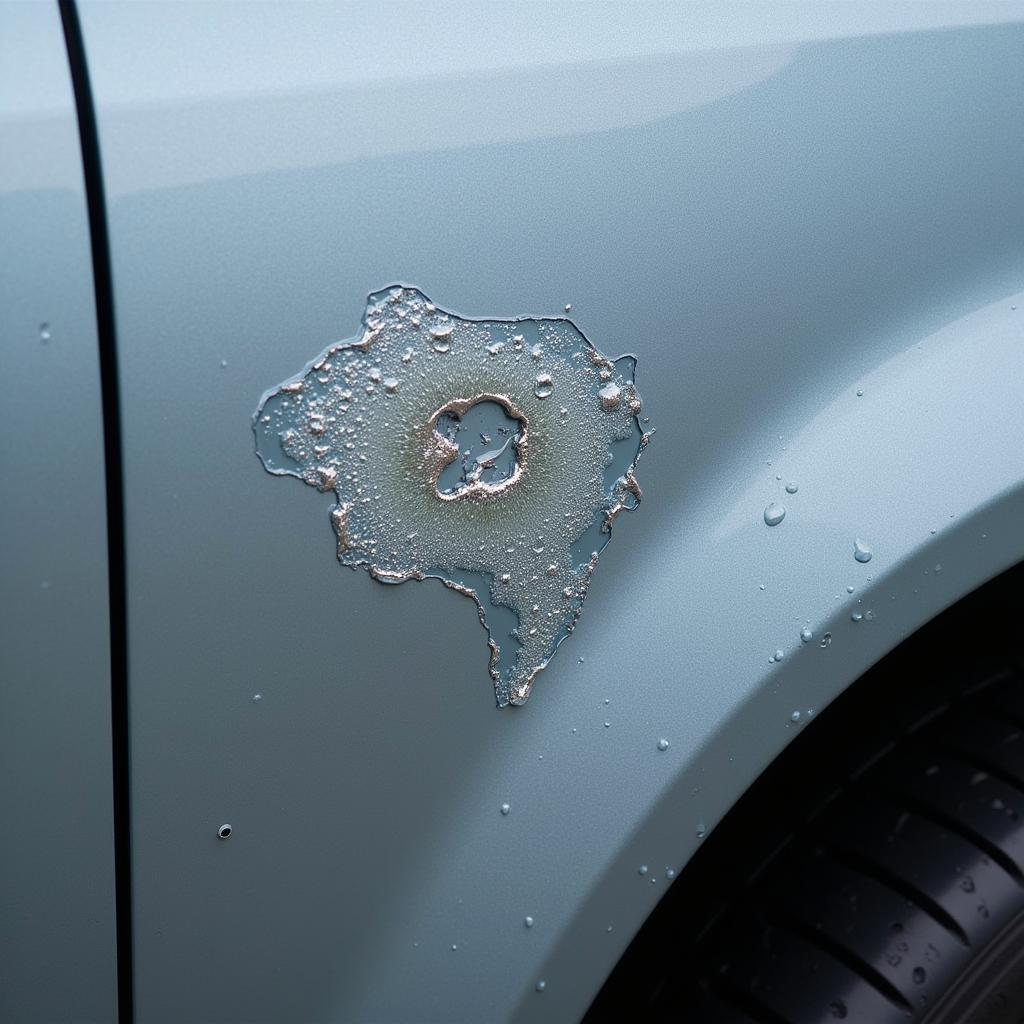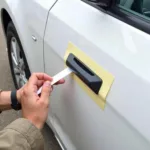Blistering car paint is a common problem that can significantly detract from your vehicle’s appearance and even lead to more serious issues if left untreated. Understanding the causes, prevention, and repair of blistering car paint is essential for every car owner. This guide will provide you with a comprehensive understanding of this issue, empowering you to take the necessary steps to protect your car’s finish.
Repairing blistered paint isn’t just about aesthetics; it’s about protecting your car’s value and preventing further damage. From identifying the root causes to exploring professional and DIY repair solutions, this article covers everything you need to know about the repair of blistering car paint. Let’s dive into the details.
Moisture is a primary culprit in the development of paint blisters. Whether it’s from a leaky car wash, trapped condensation, or exposure to humid environments, water can seep beneath the paint layers, causing them to separate and form blisters. how to repair paint blisters on car can be a challenging but rewarding task.
Understanding the Causes of Blistering Car Paint
Several factors can contribute to blistering car paint. Understanding these causes is the first step in preventing and effectively addressing the issue.
- Moisture: As mentioned earlier, moisture is a leading cause. Water trapped between the paint layers creates pressure, leading to blisters.
- Poor Paint Application: Improper surface preparation, such as inadequate cleaning or priming, can create weak points in the paint, making it susceptible to blistering.
- Sun Damage: Prolonged exposure to UV rays can weaken the paint’s chemical bonds, making it more prone to blistering and peeling.
- Chemical Exposure: Harsh chemicals, such as road salt or certain cleaning agents, can damage the paint and contribute to blistering.
- Impact Damage: Rock chips and other impacts can create entry points for moisture, leading to localized blistering.
 Blistered car paint caused by moisture trapped under the paint layers
Blistered car paint caused by moisture trapped under the paint layers
How to Identify Blistering Car Paint
Blistering paint often appears as small, raised bubbles on the car’s surface. These bubbles can vary in size and may be filled with clear liquid or air. Identifying the problem early is crucial for effective repair. Early detection can save you both time and money in the long run.
Different Types of Paint Blisters
Understanding the different types of blisters can help determine the underlying cause and guide your repair approach:
- Rust Blisters: These are often reddish-brown and indicate corrosion underneath the paint.
- Reaction Blisters: These can occur when incompatible paint products are used.
- Solvent Blisters: These are typically caused by trapped solvents during the painting process.
“Proper identification of the blister type is crucial for selecting the appropriate repair method,” says renowned auto body specialist, Robert Miller, from Miller’s Auto Restoration.
Repairing Blistered Paint: DIY vs. Professional
Depending on the severity of the blistering, you can choose between DIY repair or professional assistance.
DIY Repair of Blistering Car Paint
For minor blistering, you can attempt a DIY repair using the following steps:
- Sand the Affected Area: Carefully sand down the blistered area to remove the loose paint.
- Clean the Surface: Thoroughly clean the sanded area to remove any dust or debris.
- Apply Primer: Apply a high-quality primer to the bare metal.
- Paint and Clear Coat: Apply several thin coats of matching automotive paint, followed by a clear coat.
car paint peeling repair often involves similar steps as repairing blisters.
When to Seek Professional Help
If the blistering is extensive or involves rust, it’s best to consult a professional. They have the expertise and equipment to handle more complex repairs.
“While DIY repairs can be effective for minor blistering, extensive damage often requires the specialized tools and knowledge of a professional,” advises Sarah Chen, owner of Chen’s Auto Body Shop.
Preventing Blistering Car Paint
Prevention is always better than cure. Here are some tips to prevent blistering car paint:
- Regular Washing and Waxing: This helps protect the paint from environmental damage.
- Proper Car Storage: Store your car in a garage or covered area whenever possible.
- Prompt Repair of Chips and Scratches: This prevents moisture from penetrating the paint.
Conclusion
Repair of blistering car paint is essential for maintaining your car’s appearance and preventing further damage. By understanding the causes, prevention methods, and repair options, you can protect your vehicle’s finish and keep it looking its best. Addressing the issue promptly will save you time and money in the long run.
FAQs
- What causes car paint to blister? Moisture, poor paint application, sun damage, chemical exposure, and impact damage are common causes.
- Can I repair blistered car paint myself? Yes, minor blistering can often be repaired with DIY methods.
- When should I seek professional help for blistered car paint? If the blistering is extensive, involves rust, or you’re unsure about the repair process, it’s best to consult a professional.
- How can I prevent car paint from blistering? Regular washing and waxing, proper car storage, and prompt repair of chips and scratches are key preventative measures.
- What are the different types of paint blisters? Rust blisters, reaction blisters, and solvent blisters are common types.
- What tools do I need for a DIY blister repair? Sandpaper, cleaning supplies, primer, paint, clear coat, and application tools are typically required.
- How much does professional blister repair cost? The cost varies depending on the severity of the damage and the shop’s rates.
Need more information? Check out these related articles: how to repair blistered car paint and repair blistered paint on car. You can also find helpful tips on how to repair peeling paint on car.
Need assistance? Contact us via WhatsApp: +1(641)206-8880 or Email: [email protected]. Our customer service team is available 24/7.


